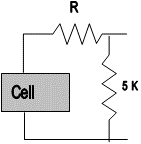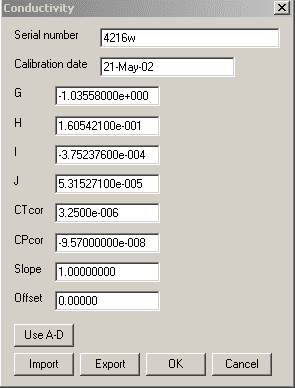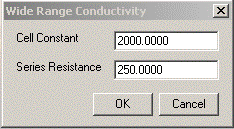![]()
This application note is applicable to the SBE 4 conductivity sensor (used on SBE 9plus, 25, or 25plus CTD) and an SBE 19 SeaCAT CTD (old version; not applicable to 19plus or 19plus V2).
On request, Sea-Bird provides a conductivity sensor that has been modified to provide conductivity readings over a wider range than our standard conductivity range. The wide-range calibration is indicated by a ‘w’ at the end of the serial number on the conductivity calibration sheet (for example, 4216w); note that the serial number on the instrument label does not include the ‘w’.
 The
modification is implemented by inserting a precision resistor in series with the
conductivity cell. Therefore, the equation used to fit the calibration data is
different from our standard equation.
The
modification is implemented by inserting a precision resistor in series with the
conductivity cell. Therefore, the equation used to fit the calibration data is
different from our standard equation.
To fit the calibration data, pseudo-conductivity is calculated from true conductivity with the following formula:
σ' = pseudo conductivity = Cσ / ( C + Rσ )
where
The calibration coefficients are generated at Sea-Bird using pseudo-conductivity, water temperature, and sensor frequency.
Procedures are provided below for processing data from a conductivity sensor with a wide-range calibration, using:
Processing Data Using your own Software
If processing data using your own software, first calculate pseudo-conductivity using the coefficients on the calibration sheet, then convert pseudo-conductivity to true conductivity using the following formula:
σ = true conductivity = Cσ' / ( C - Rσ' )
Sea-Bird’s Seasoft software (Seasave and SBE Data Processing) automatically calculates true conductivity (s) for a sensor with a wide-range calibration. On the conductivity calibration sheet, the serial number for a conductivity sensor with a wide-range calibration has a ‘w’ at the end (for example, 4216w). The 'w' in the sensor serial number in the configuration (.con or .xmlcon) file indicates to Seasoft that this is a wide-range conductivity sensor, leading the software to prompt for the cell constant and the series resistor value. Sea-Bird provides a configuration file when you purchase a new instrument, and when the instrument is recalibrated. If you need to re-create the configuration file, proceed as follows (example shown is for SBE 19).
Note: You can create or modify the configuration file in SBE Data Processing (post-processing software) or Seasave V7 (real-time data acquisition software); both programs use the same configuration file.SBE Data Processing



Seasave V7
| Date | Description |
| June 2013 | Initial release. |
![]()
Sea-Bird Home Phone: (+1) 425-643-9866 E-mail: seabird@seabird.com